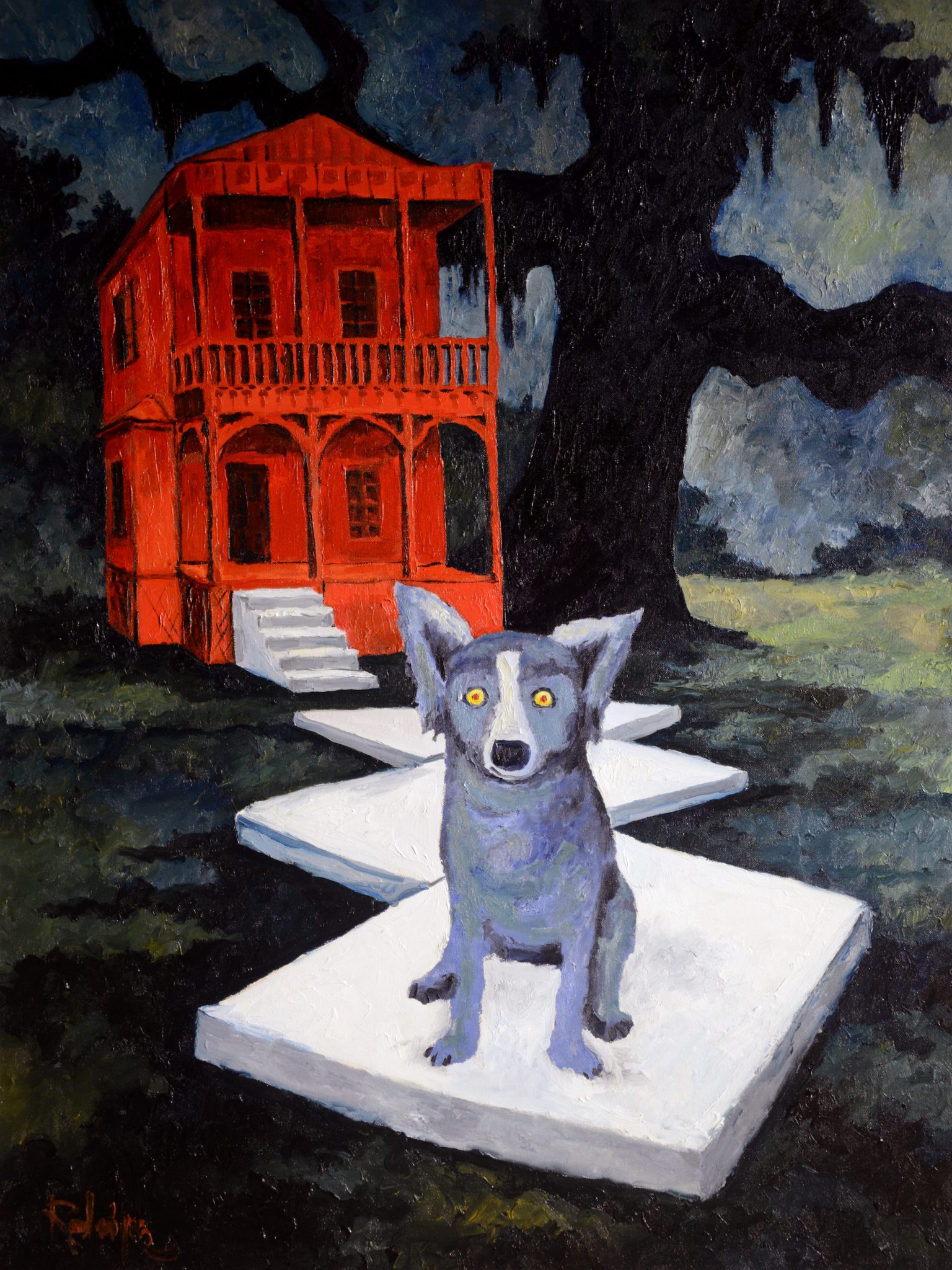Ogden Museum of Southern Art
925 Camp St
New Orleans, LA 70130
504.539.9600 | HOURS
925 Camp St
New Orleans, LA 70130
504.539.9600 | HOURS

George Rodrigue, Watchdog, 1983, Oil on canvas, 40 x 30 inches, Private Collection
George Rodrigue was a Louisiana painter known for his depictions of the landscape and people of Acadiana, as well as his later Pop Art paintings featuring the figure of a blue dog. This painting, Watchdog from 1983, was the first ever painting in what would become known as the Blue Dog series.
Born in New Iberia, Louisiana in 1944, Rodrigue attended Catholic High School on the banks of Bayou Teche before studying at the University of Louisiana at Lafayette and the Art Center College of Design in Pasadena, California. In 1968, after the death of his father, he returned to Louisiana, establishing a studio in Lafayette.
In his Lafayette studio, Rodrigue developed a wholly unique style of landscape painting focused on the oak trees of South Louisiana. His first major exhibition of 69 landscape and oak tree paintings opened in 1970 at the Old State Capital in Baton Rouge. Despite the local art critic giving it a horrible review – “Painter Makes Bayou Country Dreary, Monotonous Place” read the headline – the show sold out completely. Gradually, Rodrigue started adding figures to his landscapes, populating the dreamlike scenes with historic images of the Cajun people of South Louisiana. His most famous Cajun Painting, Aioli Dinner, was painted in 1971, using an old family photograph from 1910. Throughout the 70s and early 80s, he refined his style, exhibited widely (including twice in Paris) and published The Cajuns of George Rodrigue in 1976.
In 1980, a group of Baton Rouge businessmen commissioned Rodrigue to illustrate a book of Louisiana ghost stories to be sold at the 1984 World’s Fair in New Orleans. Over the next three years, Rodrigue completed 40 paintings to illustrate 40 stories by local author, Chris Segura. The result was Bayou (Inkwell Press, 1984), and the paintings became known as the Bayou Collection. One of the stories, Slaughter House, told the tale of an evil guard dog. Researching Cajun myth and legend for inspiration, Rodrigue remembered his mother telling him stories of the loup-garou, a Cajun version of a werewolf. As was his habit, Rodrigue combed through his personal collection of photographs, finding a photo of his own recently departed studio dog, Tiffany. Tiffany became the model for the painting. Watchdog depicts Tiffany with red eyes looking firmly at the viewer, her fur tinged blue by the moonlight. She is positioned in the foreground upon the first of three blocks resembling gravestones leading to a red house and his trademark silhouetted oak tree. The completion of this painting was a moment that would forever change the trajectory of Rodrigue’s career.
Fascinated by the strength of the shape of the figure in Watchdog, Rodrigue painted dozens of Cajun paintings featuring his loup-garou over the next few years. In 1988, during an exhibition of 60 Cajun Paintings in Los Angeles, he overheard patrons of the gallery referring to the dozen or so works with the loup-garou as “blue dog paintings.” The phrase caused the painter to see his moonlit loup-garou in a new light. Returning to his Louisiana studio, he changed the eyes from red to yellow, removing the sinister roots of the figure. He began experimenting with the figure in new ways, and the Blue Dog became a new series of its own, separate from the Cajun Paintings.
Over the next 25 years, the Blue Dog became the primary focus of Rodrigue’s studio practice. In 1991, the landscape disappeared in a painting titled Loup-Garou, and the Blue Dog replaced the Oak Tree as Rodrigue’s iconic image from that point on. In 1993, Michel Roux of Carillon Importers commissioned Absolut Rodrigue for the Absolut Vodka art campaign. Over the next two years it was published in hundreds of magazines for an international audience, taking Blue Dog global. In 2000, he was commissioned by Young & Rubicam to create paintings for worldwide advertisements promoting Xerox Color Inkjet Printers, further cementing the Blue Dog’s place in contemporary visual language.
George Rodrigue passed away on December 14, 2013. His work is held in private and public collections throughout the world. Over the course of his career, he uniquely captured the Louisiana landscape, explored Cajun culture and history, painted presidential portraits and abstracted hurricanes, and created Jazz Fest posters and ad campaigns for global audiences. But perhaps he will be most remembered for his depiction of the Blue Dog and its journey from an obscure ghost story illustration to an iconic figure in Contemporary Pop Art.